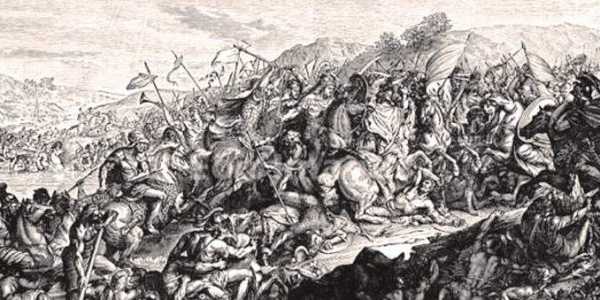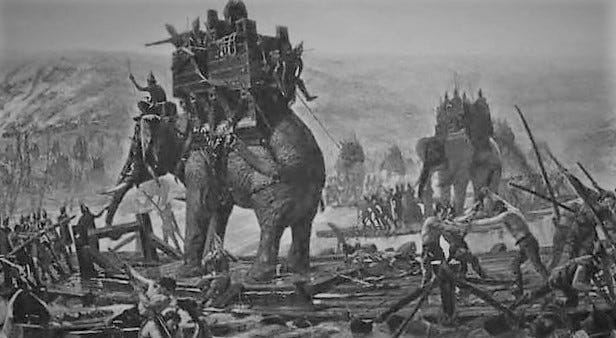Not all battles that are fought result in glorifying victory and violence. One such war, fought by King Asoka, was the battle that resulted in something different altogether. The famous Kalinga War is regarded as one of the deadliest and most catastrophic battles we know. It was Ashoka’s first and last war that took him to the path of enlightenment and Buddhism. This blog profoundly explores the history of the Kalinga War.
This Blog Includes:
Origin of the Kalinga War
One of the most talked-about wars in Indian history, the Kalinga War was fought between Ashoka, the emperor of the Mauryan empire, and the state of Kalinga, presently located near Odisha.
Kalinga was a prosperous and wealthy nation with talented artists and peaceful people. Until 321 BCE, it was ruled by the Nanda Empire. With important ports for trade and a strong navy, Kalinga controlled its coastline and played a crucial role in trading. The poet Kalidasa referred to the king of Kalinga as ‘The Lord of the Ocean’ in one of his works.

The Mauryan Empire perceived Kalinga as a threat because they could interrupt communications between Patliputra, the Mauryan capital and its possessions in the central Indian peninsula. Hence, that is why Ashoka wanted to conquer Kalinga. But the Kalinga King refused to surrender which prompted Ashoka to wage a war against the empire.
The Kalinga War was Ashoka’s only major war after ascending the throne. It marked the end of ancient India’s empire-building and military conquests, which commenced with Mauryan King Bindusara. It involved bloodshed and cost a staggering 2,50,000 casualties.
Also Read: Battle of Khanwa
Causes of the Kalinga War
Historians have different views about the causes of the Kalinga War. The definite causes behind the deadliest battle in Indian history, have been elucidated below-
- King Ashoka wanted to embark upon the path of his father, Bindusara, and grandfather, Chandragupta Maurya. During the reign of the Nandas, Kalinga was a province of the Magadha Empire.
- Kalinga became an independent state after the Nandas were defeated by Chandragupta Maurya. While Chandragupta Maurya and Bindusara attempted to re-conquer it, they were unsuccessful. It was Ashoka who led the charge to reclaim the throne.
- Since the reign of Chandragupta Maurya, Kalinga was renowned for its military power, and trade relations with regions such as Malay, Ceylon, and Java. Kalinga was a prosperous and wealthy region as well. These reasons propelled Ashoka to conquer Kalinga and expand his kingdom.
- In the 12th year of Ashoka’s reign, he sent a message to the ruler of Kalinga, requesting that his empire be submitted to the Mauryas. However, Kalinga’s ruler refused to submit to the Mauryan Empire. In 261 BC, a deadly war was waged between Ashoka and the state of Kalinga.
Also Read: Battle of Haldighati
Strength of the Warring Forces
There were only 60,000 infantry, 1,000 cavalries, and 700 elephants in the Kalinga army. The Greek ambassador Megasthenes, on the other hand, mentioned Mauryan’s military strength as being around one lakh, consisting of 1700 horses, thousands of elephants, and 60 thousand soldiers. This clearly illustrates that Ashoka’s army was way mightier than that of the Kalinga army.

Main Battle
Given below is the apt and accurate description of the Kalinga War
- In 261 BC, the people of Kalinga put up a valiant and brave fight against the Mauryan army. Kalinga transformed into a battleground. The ruler of Kalinga, Kalingaraj left no stone unturned to defeat the Magadha empire but their massive army outnumbered and overpowered the army of Kalinga.
- Historians recount that the soldiers of Kalinga persisted till their last breath and were close to victory. However, Ashoka and his men overpowered them and emerged triumphant in the battle.
- The Kalinga War fought near River the Daya River is still one of the deadliest and largest battles fought in the Indian history
Also Read: Battle of Plassey 1757
Effects of the Kalinga War
Who won the Kalinga War and the result of the battle was clear, Ashoka emerged triumphant and conquered Kalinga. But there was a twist in the story afterwards-
- The Kalinga War resulted in massive loss of life and property. 1,00,000 soldiers were killed in the battle and 1,50,000 soldiers from Kalinga were captured by King Asoka, who later succumbed to death.
- Ashoka successfully conquered Kalinga. It became the fifth province of the Magadha Empire along with Prachaya, Avanti, Uttarapatha, and Dakshinapatha.
- However, it was an empty and shallow victory, because of the massive loss of life and property.
- The Kalinga War was the only battle in the world, where the conqueror gave up his sword and forbade his kingdom. Ashoka decided to embrace Buddhism and embarked upon a mission to spread Buddhism in India and neighbouring countries.
- He played a pivotal role in spreading Buddhism from the Himalayas to Ceylon and from Greece to Burma.
Also Read: List of Anglo Mysore Wars [1767 -1799]
Significance of the Battle in Indian History
Even after emerging triumphant, Ashoka the Great was dissatisfied and dejected. He was filled with grief and gloom as he witnessed Kalinga’s deteriorating condition, replete with blood, agony and tears all over him. Kalinga suffered an irreparable loss. Ashoka was drenched in self-centeredness and greed for power which had blinded him. But after witnessing the agony, deaths and bloodshed on the battleground, his cold heart melted and he amended his path for good.
Post the battle, Ashoka became a follower of Buddhism. He promised that he would never walk upon the path of violence. He ended the military expansion of the empire. The Kalinga war became his first and last war.
The empire adopted a new policy of peace and non-violence. Except for the extreme southern part of the Indian subcontinent, Ashoka controlled the entire Indian subcontinent after the Kalinga War.
His Dhamma laws were carved into rocks and stone pillars. Missionaries were sent to other countries to preach Buddhism and Dhamma so that more people could adapt to a non-violent way of life.
Also Read: Timeless Teachings of the Dalai Lama
FAQs
One of the most talked-about wars in Indian history, the Kalinga War was fought between Ashoka, the emperor of the Mauryan empire, and the state of Kalinga, presently located near Odisha.
The Kalinga War resulted in massive loss of life and property. 1,00,000 soldiers were killed in the battle and 1,50,000 soldiers from Kalinga were captured by King Asoka, who later succumbed to death.
Even after emerging triumphant, Ashoka the Great was dissatisfied and dejected. He was filled with grief and gloom as he witnessed Kalinga’s deteriorating condition, replete with blood, agony and tears all over him. Kalinga suffered an irreparable loss. Ashoka was drenched in self-centeredness and greed for power which had blinded him. But after witnessing the agony, deaths and bloodshed on the battleground, his cold heart melted and he amended his path for good.
This was all about the Kalinga War. We hope that you found the blog to be impactful and are moved by the drastic transformation of Ashoka. For more intellectually stimulating and informative blogs like these, please stay connected with Leverage Edu and follow us on Facebook, Instagram, and LinkedIn.
-
I am in need of images of the flags of Ashoka & king Kharavela during Kalinga war to know the emblems of both dynasties at the time of war.

 One app for all your study abroad needs
One app for all your study abroad needs





















 45,000+ students realised their study abroad dream with us. Take the first step today.
45,000+ students realised their study abroad dream with us. Take the first step today.


1 comment
I am in need of images of the flags of Ashoka & king Kharavela during Kalinga war to know the emblems of both dynasties at the time of war.